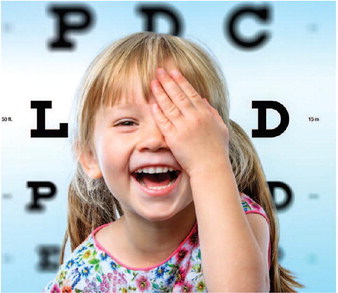Child’s Eye Health and Safety Month


August is …
Eye conditions that can affect children
While a loss of visual acuity is often associated with senior citizens, various diseases and conditions of the eye can affect children. The American Academy of Opthalmology says many conditions and diseases can impact a child's vision. Early diagnosis and
treatment are critical to improving
a youngster's eye health and helping
him or her see and feel better.
Learning about certain conditions and how to recognize their accompanying symptoms can help parents ensure kids get the treatment they need.
Amblyopia
Often referred to as 'lazy eye,' amblyopia may be characterized by reduced vision in an eye that has not received adequate use during early childhood. Amblyopia may result from misalignment of a child's eyes or
from one eye focusing better than the other. If left untreated, the weaker eye can continue to weaken until it is ren- dered useless. Sight in the a-ected eye
can be restored if treatment is begun
early, says Prevent Blindness Amer ica. Glasses, eye exercises or surgery may be prescribed to help fix the underlying causes of the condition.
Astigmatism
Astigmatism is a condition
wherein objects viewed at both a dis tance and close up can appear blurry.
Experts say it occurs from the uneven
curvature of the cornea or lens, which prevents rays of light from entering the eye and focusing on a single point on the retina, otherwise known as a refractive error. Prescription eyeglass es often fix astigmatism. All About Vision also says that refractive surgery may correct astigmatism.
Color blindness (color vision deficiency) The main symptom of color
blindness is diculty distinguishing
between colors or making mistakes when identifying colors, particularly
those shaded red and green. Typi cally by age five, children with normal color vision will be able to identify groups of colors, so if a school-aged child is having diculty or showing
disinterest in coloring, he or she may benefit from a colorblindness test.
(e National Eye Institute says color
blindness is much more common in males than in females.
Pediatric glaucoma
This rare condition, also known as congenital glaucoma, occurs in infants and young children. The Glaucoma Research Foundation says incorrect development of the eye's
drainage system before birth leads to increased intraocular pressure, which
can damage the optic nerve. Enlarged
eyes, corneal cloudiness and sensitiv-
ity to light can be symptoms. Medica tion and surgery are required in most cases.
Strabismus
Strabismus is a condition of mis aligned eyes. It occurs when the eye muscles fail to work together and the eyes turn inward, outward, upward, or downward. By the age of three to four months, an infant's eyes should
be able to focus and be straight and
parallel. Parents should consult an
eye care professional if they notice eye alignment problems in their children.
Pink eye (conjunctivitis), diabe tes-related eye problems and other refractive errors also can occur in children. Routine eye examinations can identify problems and get children the treatment they need.


